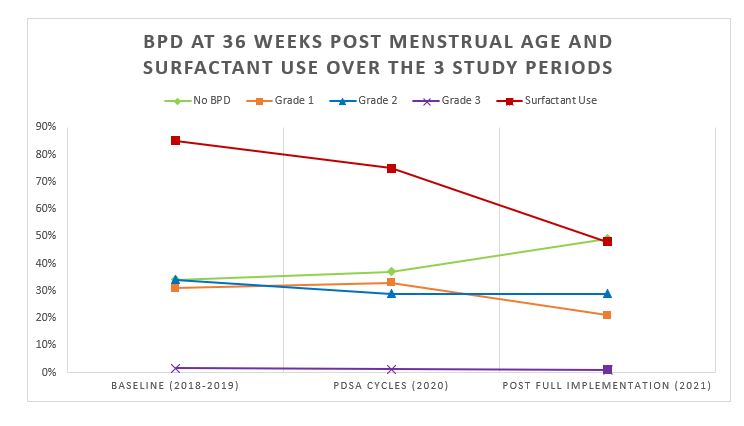Neonatal Quality Improvement
Category: Abstract Submission
Neonatal Quality Improvement I
206 - Decrease in bronchopulmonary dysplasia rates following implementation of a comprehensive care bundle
Friday, April 22, 2022
6:15 PM - 8:45 PM US MT
Poster Number: 206
Publication Number: 206.126
Publication Number: 206.126
Dhruv Gupta, Pediatrix, El Paso, TX, United States; Deepak Yadav, Mednax, Las Cruces, NM, United States; Sigal Peter-Wohl, El-Paso Pediatrix, Chapel Hill, NC, United States; Marcella Mascher Denen, Mednax, Pagosa Springs, CO, United States; Marryam S. Khan, Pediatrix Medical Group, Houston, TX, United States; Mia M. Guerrero, Mednax Pediatrix Medical Group, El Paso, TX, United States; Jena L. Petry, Mednax, El paso, TX, United States; Karina Garcia, Mednax, El Paso, TX, United States; Gregory P. Welch, Pediatrix, El Paso, TX, United States

Dhruv Gupta, MD
Medical Director
Pediatrix
El Paso, Texas, United States
Presenting Author(s)
Background: Bronchopulmonary dysplasia (BPD) is a major morbidity associated with preterm birth. Comparison of outcome data from the Pediatrix clinical data warehouse showed that the average BPD rates and surfactant use from 2018-2019 in the neonatal intensive care units (NICUs) covered by our practice group were greater than the national average.
Objective: This quality improvement project sought to improve the rate of survival without BPD by at least 10% and decrease surfactant use by at least 30% in preterm infants by implementing a prevention bundle.
Design/Methods: The study included all infants with gestational age ≤ 32 weeks and birth weights from 501 to 1500 g born at seven different NICUs in El Paso, TX and Las Cruces, NM from 2018-2021 and survived till 36 weeks post menstrual age. These NICUs are covered by the same neonatology practice group. The study was divided into 3 periods: 1, baseline (2018-2019); 2, initial changes based on cycles of Plan-Do-Study-Act (2020); and 3, post full implementation of the BPD prevention bundle (2021). The bundle included strategies on delivery room interventions, management of respiratory distress syndrome, surfactant use, patent ductus arteriosus, post-natal steroid use and late onset sepsis guidelines, feeding protocol and regular meetings to discuss high risk infants. The primary outcome was Survival without BPD (NO BPD) which was defined as no supplemental oxygen or flow at 36 weeks post menstrual age. Other measures included BPD severity grade (Jensen Grading) at 36 weeks post menstrual age and rate of surfactant use.
Results: The study population over the 3 periods included a total of 372 infants. Out of these 191 infants were included in the baseline data (2018-2019) and 86 infants were included in the post full implementation data (2021). NO BPD rate improved significantly post full implementation, from 33.5% to 48.8% (P value 0.01). There was a trend towards improvement in Grade 1 BPD (31.4% to 20.9%), Grade 2 BPD (33.5% to 29.1%) and Grade 3 BPD (1.6% to 1.2%) when baseline rates were compared with rates post full implementation. Surfactant use decreased significantly from 85% at baseline to 48% post full implementation (P value < 0.01).Conclusion(s): A prevention bundle implementation across different hospitals by a neonatology group successfully increased rates of survival without BPD and decreased surfactant use, in preterm infants. The future goal is to continue to optimize the BPD prevention bundle and further decrease our rates of BPD.
Table: BPD rates at 36 weeks post menstrual age.jpg) Abbreviations: BPD: Bronchopulmonary dysplasia; NO BPD: no supplemental oxygen or flow; Grade 1 BPD: Nasal Cannula, Hood oxygen, Supplemental oxygen, Tracheal oxygen; Grade 2 BPD: Endotracheal continuous positive airway pressure, High flow nasal cannula, Nasal prong ventilation, Nasal continuous positive airway pressure, Tracheal continuous positive airway pressure; Grade 3 BPD: Ventilator, Jet Ventilator, Oscillator
Abbreviations: BPD: Bronchopulmonary dysplasia; NO BPD: no supplemental oxygen or flow; Grade 1 BPD: Nasal Cannula, Hood oxygen, Supplemental oxygen, Tracheal oxygen; Grade 2 BPD: Endotracheal continuous positive airway pressure, High flow nasal cannula, Nasal prong ventilation, Nasal continuous positive airway pressure, Tracheal continuous positive airway pressure; Grade 3 BPD: Ventilator, Jet Ventilator, Oscillator
Figure - BPD rates at 36 weeks post menstrual age and surfactant use over the 3 study periods
Objective: This quality improvement project sought to improve the rate of survival without BPD by at least 10% and decrease surfactant use by at least 30% in preterm infants by implementing a prevention bundle.
Design/Methods: The study included all infants with gestational age ≤ 32 weeks and birth weights from 501 to 1500 g born at seven different NICUs in El Paso, TX and Las Cruces, NM from 2018-2021 and survived till 36 weeks post menstrual age. These NICUs are covered by the same neonatology practice group. The study was divided into 3 periods: 1, baseline (2018-2019); 2, initial changes based on cycles of Plan-Do-Study-Act (2020); and 3, post full implementation of the BPD prevention bundle (2021). The bundle included strategies on delivery room interventions, management of respiratory distress syndrome, surfactant use, patent ductus arteriosus, post-natal steroid use and late onset sepsis guidelines, feeding protocol and regular meetings to discuss high risk infants. The primary outcome was Survival without BPD (NO BPD) which was defined as no supplemental oxygen or flow at 36 weeks post menstrual age. Other measures included BPD severity grade (Jensen Grading) at 36 weeks post menstrual age and rate of surfactant use.
Results: The study population over the 3 periods included a total of 372 infants. Out of these 191 infants were included in the baseline data (2018-2019) and 86 infants were included in the post full implementation data (2021). NO BPD rate improved significantly post full implementation, from 33.5% to 48.8% (P value 0.01). There was a trend towards improvement in Grade 1 BPD (31.4% to 20.9%), Grade 2 BPD (33.5% to 29.1%) and Grade 3 BPD (1.6% to 1.2%) when baseline rates were compared with rates post full implementation. Surfactant use decreased significantly from 85% at baseline to 48% post full implementation (P value < 0.01).Conclusion(s): A prevention bundle implementation across different hospitals by a neonatology group successfully increased rates of survival without BPD and decreased surfactant use, in preterm infants. The future goal is to continue to optimize the BPD prevention bundle and further decrease our rates of BPD.
Table: BPD rates at 36 weeks post menstrual age
.jpg) Abbreviations: BPD: Bronchopulmonary dysplasia; NO BPD: no supplemental oxygen or flow; Grade 1 BPD: Nasal Cannula, Hood oxygen, Supplemental oxygen, Tracheal oxygen; Grade 2 BPD: Endotracheal continuous positive airway pressure, High flow nasal cannula, Nasal prong ventilation, Nasal continuous positive airway pressure, Tracheal continuous positive airway pressure; Grade 3 BPD: Ventilator, Jet Ventilator, Oscillator
Abbreviations: BPD: Bronchopulmonary dysplasia; NO BPD: no supplemental oxygen or flow; Grade 1 BPD: Nasal Cannula, Hood oxygen, Supplemental oxygen, Tracheal oxygen; Grade 2 BPD: Endotracheal continuous positive airway pressure, High flow nasal cannula, Nasal prong ventilation, Nasal continuous positive airway pressure, Tracheal continuous positive airway pressure; Grade 3 BPD: Ventilator, Jet Ventilator, OscillatorFigure - BPD rates at 36 weeks post menstrual age and surfactant use over the 3 study periods

